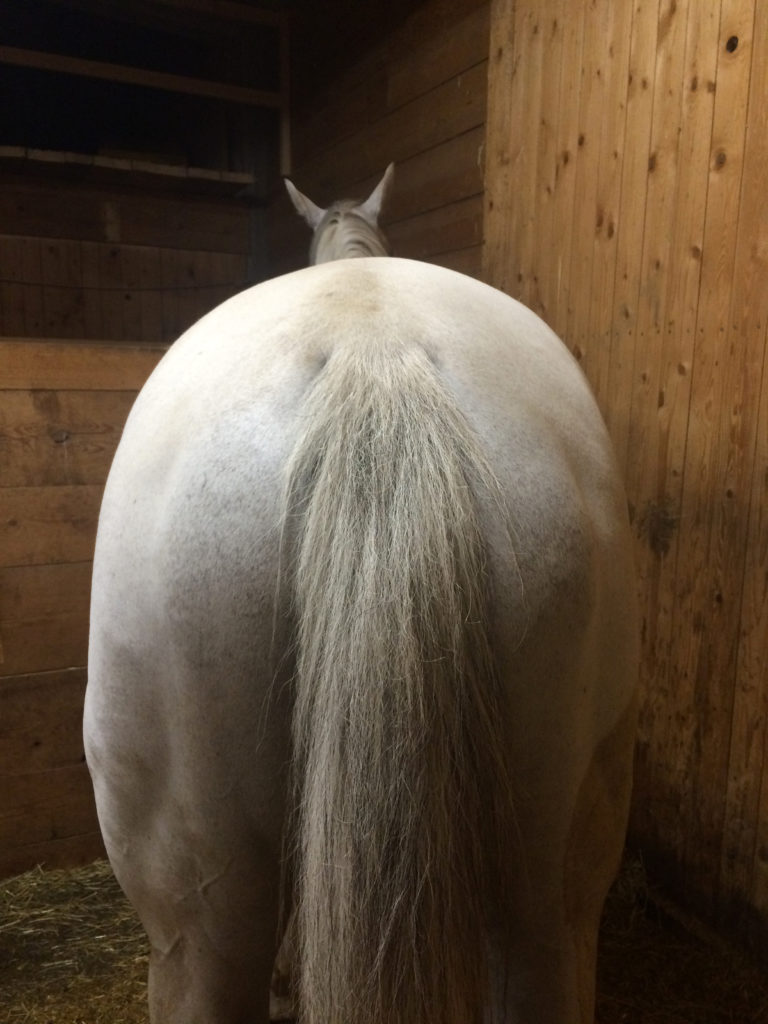ASYMMETRY IN HORSES BY KATJA PORENTA
IT DEPENDS ON THE CONTEXT
Every horse is asymmetrical and so is every rider. Perfect symmetry is very rare in nature as every being is constantly being shaped by its genetics, its experiences and its lifestyle. Form follows function, which means that asymmetries that we can spot in our horses are a consequence of how the horse is using his body.
Asymmetry can give us important insight into how the horse is responding to our training. This is especially true about asymmetric development of muscles. But asymmetry is only a clue, it’s not an answer. In the case of muscles, it is fairly easy to say, if the left muscle is bigger than the right, that must mean the horse is using the left muscle more. But then you have to ask yourself is the horse using his left muscle too much or is the horse not using his right muscle enough? Is it a case of hypertrophy of the left muscle or a case of atrophy of the right one? Which muscle is “just right”? The same goes for pelvic asymmetries. If you have a horse whose left side of the pelvis (his tuber coxae) is higher than the right, does that mean the left side is too high or is the right one too low? It’s hard to tell unless you see the horse move and palpate his fascia and muscles. You can usually get a good clue about which side is just right if you assess the movement of the pelvis. The dysfunctional side will usually be the one that is stiff and blocked in its range of movement. This is why we always have to look at asymmetry in context of movement.

PELVIC ASYMMETRY
Take for example the photo of the grey horse above with the obvious pelvic asymmetry. This particular horse had a pelvic fracture when she was young and the asymmetry is due to how the pelvis healed. No amount of bodywork or training will make that horse symmetrical. You can however make her pelvis functional again with good bodywork and proper training. But horses with asymmetrical pelvises are really common and most of them didn’t suffer a fracture. It might be a case of something simple like the psoas muscle and the fascia surrounding the area being restricted and once that’s resolved the pelvis becomes symmetrical again. It might be restrictions in the fascia of the sacro-iliac area that’s making the pelvis look asymmetrical, it might be an old injury of the pelvic ligaments. Or it could be just uneven development of muscles due to the horse lacking balance during training.

ASYMMETRICAL HOOVES
The example on the next photo above is even more complex. Most horses have naturally asymmetrical hooves – one foot has a higher heel and the other one has a longer toe. This has in part to do with their grazing preference and their “handedness”. Some argue that it might even depend on the horse’s position in the uterus, so the appearance of the hooves is complex even before you add the wear and tear of an average horse. Injuries and compensation patterns can make the asymmetry worse. The horse on the photo was an ex racehorse and a broodmare. She sustained a tendon injury on the track and was put out to pasture when she was six. She is 15 in the photo. Even though the injury had long since healed, she still retained a compensatory movement pattern, which made her hooves asymmetrical. Perhaps she could be made more symmetrical if she was properly rehabilitated and put into light work. With a horse that has been compensating for an injury for almost ten years, this would be a slow process and it would probably take at least a year. Despite her asymmetry, she was comfortable in the pasture and didn’t show any signs of discomfort.

LEANING ON ONE SHOULDER
The last example (photo above) is a much simpler one. This is a young horse that liked to lean on one of his shoulders while being worked. The owner did a lot of ground work with him, but didn’t realize the horse had been “cheating” and leaning on one of his shoulders at every work session. Eventually this caused his muscles and movement to become asymmetrical. As the training progressed, he wasn’t making progress anymore as he developed issues with correct bend. At this point the owner noticed the issue and started looking into it. After a couple of bodywork sessions and a training plan aimed at teaching the horse to move in a balanced way the horse became symmetric in appearance and movement in a matter of months.
When it comes to asymmetries there is no clear-cut answer as to what caused it and how fast or to what degree it can be corrected. More important than appearance is functionality, so the aim should always be to enable the horse to move in a balanced, symmetrical way. The body will adapt and the asymmetries will become less pronounced, but some horses will always have some level of asymmetry. And that’s perfectly fine – the important thing is that the horse is comfortable in his body and fit for his job.






